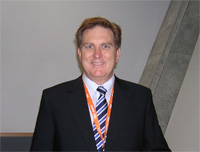|
|
||
|
Development of a New Imaging Option to Allow Safe MR Scans in Patients with AIMDs |
||
|
||
|
During the Educational and Scientific meetings of the SMRT and ISMRM held in Melbourne, Australia, May 2012, presentations introduced a plan to address the safety of scanning patients with Active Implanted Medical Devices (AIMDs). An AIMD is any implanted device that uses power, including but not limited to implanted pumps, neurostimulators, bone growth stimulators, cardiac pacemakers and defibrillators. Michael Steckner, PhD, of Toshiba Medical Research Institute USA, co-convenor of the international Joint Working Group (JWG) presented the current status of this topic at the SMRT meeting. Dr. Steckner explained that after six years of work, there has been a recent agreement between the MR manufacturers and AIMD vendors to include a new mode of scanner operation that will limit the RF transmit field (B1) and the rate of change (slew rate, mT/m/sec) of the encoding gradients to specific agreed levels. The manufacturers of future AIMDs will design their devices to operate successfully and without risk to the patient within these limits, and label them as such. MRI manufacturers will provide an “option button” that limits RF field and slew rate values to agreed limits, in addition to the existing SAR information. The button invoking this mode will set these limits and restrict the performance of the MR scanner so that its RF and gradient switching cannot create harmful interactions with specifically designed and labelled AIMDs for the entire scan session. Using the “button” will significantly restrict the performance of the scanner, and so technologists, radiographers and radiologists will need to accommodate the lower performance into the examination plan. The MT40 and JWG believe that this method will ensure safe scanning of patients with AIMDs. The international MR safety standards team (MT40) is now writing this proposal into draft standards and refers to the operational limits as the “Fixed Parameters Option: Basic” (FPO: B) to control MRI scanner performance for AIMD purposes. However, they understand that this interim name, created by engineers and scientists, may not clearly communicate the concept to the daily scanning staff, technologists, radiographers and radiologists who will use it. The MT40 are looking to MR users to give them additional suggestions. They would prefer something that is distinct from the “modes” currently defined in the MR safety standards (normal operating mode, first level controlled operating mode, second level controlled operating mode). There is also a desire from regulatory bodies to avoid the word “implant” because it might then be assumed to be appropriate for any and/or all types of implants. The name should be “universal” as they wish to avoid names that are difficult, confusing or possess unintended meanings when translated beyond the English language. Finally, they would like to develop a name that has some room for future growth, as there may be other sets of limits in the future depending on experiences with this initial design. Currently the MT40 needs suggestions for a name for this imaging option from the working MR community. The SMRT was asked to seek out ideas from within and beyond its membership. Therefore, this is an open call to MR technologists and radiographers of all skill levels and training to give us suggestions for the name of the button that will control this mode of operation for AIMDs. SMRT web resources are being used to communicate this request in addition to social media such as Facebook and Twitter and the SMRT MR Technologists email list server. The SMRT Executive Committee will provide these suggestions to the MT40 and the JWG.
Please submit all ideas for names for this new
option to SMRT President Vera Kimbrell at Email
bvdmiller@mac.com
by 15 June 2012. |

